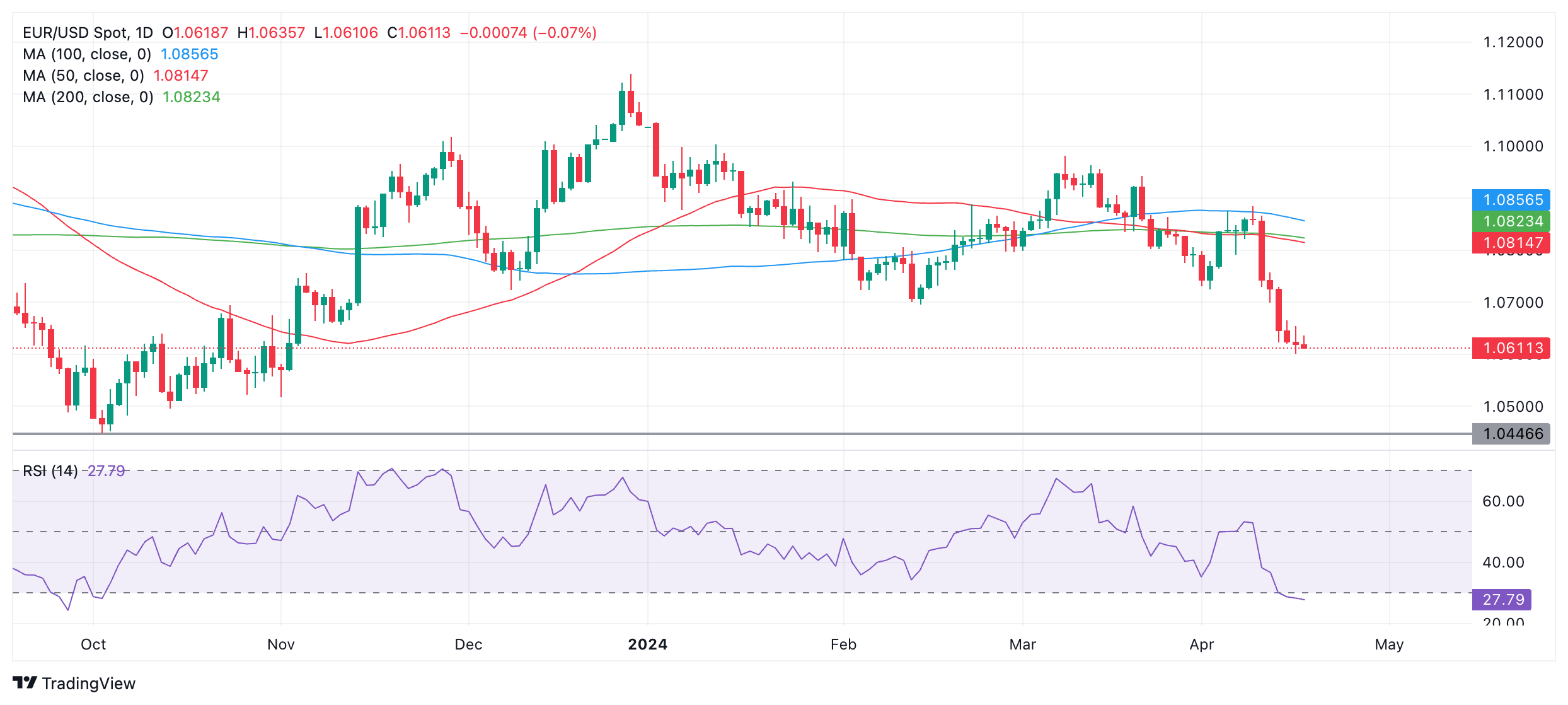EUR/USD recovers after final Eurozone inflation reading
- EUR/USD recovers after the release of HICP inflation data for the Eurozone.
- Speeches by several key ECB governing council members could also impact EUR/USD.
- EUR/USD enters oversold levels on the daily chart, indicating risk of a pullback.
EUR/USD rebounds by about two-tenths of a percentage point into the mid 1.0600s on Wednesday after the release of the final estimates for Eurozone March Inflation data.
EUR/USD: recovers after final estimates, ECB speeches
EUR/USD saw a lift on Tuesday after the final reading of the Harmonized Index of Consumer Prices (HICP) came out in line with the iinitial estimates at 2.4% year-on-year. This was down from 2.6% YoY in February.
The Core HICP showed a 2.9% rise YoY also in line with flash estimates, from 3.1% in February. Month-on-month readings were also in line with initial estimates.
The lack of change in the final estimate may have taken the heat out of increasingly dovish expectations regarding interest rates. A rate cut in June is now widely expected, and since lower interest rates, or their expectation, tend to reduce foreign capital inflows, this has been depreciating the Euro (EUR) and pushing down EUR/USD.
Speeches by key ECB members throughout the day, including ECB Executive Board Member Piero Cipollone, ECB Executive Board Member Isabel Schnabel and President Christine Lagarde herself could also impact the pair’s volatility.
The case for an imminent cut in interest rates – the ECB’s key main refinancing operations rate stands at 4.50% – was strengthened on Tuesday after ECB President Christine Lagarde said that the ECB will cut rates soon, bar a surprise, and that the ECB was keeping a close eye on Oil prices due to tensions in the Middle East.
The pair has been in the oversold zone on charts, increasing the odds of an upward correction potentially evolving on the horizon.
Technical Analysis: EUR/USD bears are oversold
The EUR/USD pair is firmly in a downtrend on both its short and medium-term time frames, since peaking and rolling over at 1.1139 in December.
EUR/USD Daily Chart
The downtrend thesis is supported by the fact that the pair is trading below all its key major moving averages – the 50-day, 100-day and 200-day Simple Moving Averages (SMA).
It is making lower lows and lower highs and this trend is biased to continue – with one caveat.
The Relative Strength Index (RSI) momentum indicator is flashing oversold on the daily chart. At the moment this is only a warning for short-traders not to add to their positions, however, if the RSI were to exit oversold and rise back above 30, it would be a sign the pair was correcting and for short-traders to close their positions and open longs.
As things stand it is still possible the pair could continue lower and even if there is a correction the dominant downtrend is still likely to resume. The next key downside target for the pair is the 2023 lows at 1.0446.
If a pullback evolves, meanwhile, a possible target could be the swing low at 1.0700.
ECB FAQs
The European Central Bank (ECB) in Frankfurt, Germany, is the reserve bank for the Eurozone. The ECB sets interest rates and manages monetary policy for the region. The ECB primary mandate is to maintain price stability, which means keeping inflation at around 2%. Its primary tool for achieving this is by raising or lowering interest rates. Relatively high interest rates will usually result in a stronger Euro and vice versa. The ECB Governing Council makes monetary policy decisions at meetings held eight times a year. Decisions are made by heads of the Eurozone national banks and six permanent members, including the President of the ECB, Christine Lagarde.
In extreme situations, the European Central Bank can enact a policy tool called Quantitative Easing. QE is the process by which the ECB prints Euros and uses them to buy assets – usually government or corporate bonds – from banks and other financial institutions. QE usually results in a weaker Euro. QE is a last resort when simply lowering interest rates is unlikely to achieve the objective of price stability. The ECB used it during the Great Financial Crisis in 2009-11, in 2015 when inflation remained stubbornly low, as well as during the covid pandemic.
Quantitative tightening (QT) is the reverse of QE. It is undertaken after QE when an economic recovery is underway and inflation starts rising. Whilst in QE the European Central Bank (ECB) purchases government and corporate bonds from financial institutions to provide them with liquidity, in QT the ECB stops buying more bonds, and stops reinvesting the principal maturing on the bonds it already holds. It is usually positive (or bullish) for the Euro.


